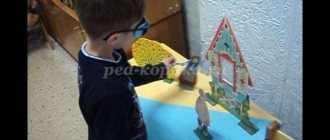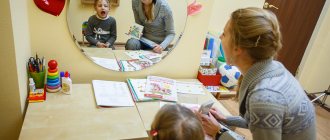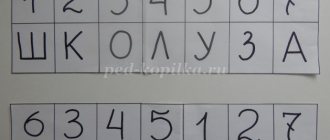- home
- Speech development
Individual lessons with a speech therapist are necessary to establish and automate correct sound pronunciation.
This method of work is necessary for children with speech pathologies and physiological disorders of the articulatory apparatus. Classes are devoted to the production and automation of groups of phonemes or individual sounds. The topic of today's lesson: “Sound [S]”. During the lesson we use methods of sound production [С] and [Ш], developed for correctional work with preschoolers.
Tasks
Educational:
- Setting and assigning the phoneme [C] in reflected repetition to the teacher, independently.
- Enrichment of the dictionary.
Corrective:
- Formation of syllabic analysis skills.
- Fixing the sound [S] in isolation, in syllables, words, sentences.
- Development of thinking, memory, attention.
- Development of phonetic hearing.
- Development of motor skills of articulation organs and fingers.
Educational:
- Maintaining interest in learning and working with a speech therapist.
- Cultivating hard work.
- Developing the skill of controlling sound pronunciation. Equipment
To conduct the lesson in a fun way, you will need a toy (for example, a bear, an elephant), a mirror, pictures of articulation exercises, a sound ruler, cards with letters and images of objects, and syllable diagrams.
Types of incorrect sound pronunciation
Children often try to replace the sound “C” with other consonants, the pronunciation of which is easier and does not require additional work of the tongue muscles. For example, replacing “C” with “S” (syplenok, rash, rash, rash), with “T” (chicken, typ, typ, typ), sometimes with “F” and “Ch” (fyplenok, phyp, phyp, fip, chiplenok, chip, chip, chip).
First, the adult asks the child to pronounce a control phrase (Chicken Little has a chain) to determine the correct pronunciation of the morpheme. Based on this, the speech therapist determines the method of sound production. If the child’s tongue tries to jump out of the mouth when pronouncing “C,” then we are talking about interdental sigmatism.
A teaspoon, with which you need to hold the tongue behind the lower teeth, will help correct this speech impediment.
When “C” in speech is replaced by sibilants, this is called sibilant sigmatism. In this case, we make the sound “C” by imitation using a mirror.
If “C” is replaced by the letter “F” during pronunciation, then the child has labiodental sigmatism. The index finger will help to cope with this problem, with the help of which you need to hold the lower lip while pronouncing the morpheme. As soon as the labial articulation returns to normal, the supports can be removed.
Progress of the lesson
Organizing time
Good afternoon, Zakhar (child’s name). Today we will meet a guest. He came to us to see what you were doing in class, to help you do exercises and play.
Come on, let's meet him. The elephant's name is Semyon. How are you?
We got acquainted, now we’ll tell the elephant what we’ll do today.
Let's learn how to pronounce the sound [C] correctly and repeat exercises to warm up the face, fingers, and tongue. Let's look at interesting pictures from fairy tales and come up with our own story. And Semyon will help us and learn too. What sound does the elephant's name begin with? (the child answers), and your name is Well done.
Game “Hear and Clap”
Goal: to develop phonemic awareness.
- Let's play a game. I will name the words, and you will clap your hands if you hear the sound [C].
Sleigh, broom, elephant, owl, cat, bag.
- Well done. The elephant praises you too. He is proud of you, wants to be just as smart and attentive.
Now let's get ready to warm up.
Articulation gymnastics
To produce the sound [C], articulatory gymnastics must be used. Completing tasks helps to relax the muscles, feel the position of the oral organs, and set them up for work. This stage cannot be excluded from speech therapy sessions.
Massage: Repeat the steps after me. Rub your palms and fingers. Stroke yourself on the cheeks, forehead (3-4 times). Move your hands to your ears, rub the earlobes (3-4 times). Rub over the lips, under the chin (3-4 times).
Articulation exercises: Performed in front of a mirror or without it, the child repeats the movements after the teacher.
- Smile
We stretch the sponges as far as possible to the sides. We hold the smile for a few seconds, then relax the muscles. 2-3 repetitions.
- Spatula
We smile, open our mouth, and place our tongue on our lower teeth. We slap our tongue on our lips and say: “Bya, five, five, bya.”
- Jam
We lick our lips as if they were smeared with a sweet treat.
- Needle
Stick out your sharp tongue, pull it out as far as possible, and now hide it back. Repeat.
Well done. Our tongue and lips are ready for the lesson.
Breathing exercises
Helps the child relax, take a break from articulations, and get ready for further work. Do 2-3 breathing exercises with your preschooler.
- Puffing out our cheeks
Come on, let's make Semyon laugh. Let's show him how a fish breathes underwater. Take air into your mouth and puff out your cheeks. Try not to release it right away, hold it. Then puff up one cheek, then the other.
- Trumpeter
Pull the sponges into a tube. Take air into your lungs and blow it out through a thin slit in your mouth, as if you were blowing out a candle.
Finger gymnastics
Now let's stretch our fingers. Let's make a “Lock”, “Ring Fist”.
Sound production
The main part of the lesson. The sound [C] is produced using a mirror. The child must follow the movements of the articulatory apparatus. Fix the correct positions of the lips and tongue. These exercises and methods can be used as ways to create whistling sounds in future classes.
- First, let's tell the elephant how we pronounce the sound [C]. Show what the tongue, lips, teeth do, how the air passes. Let's remember together.
- Fold your lips into a smile, clench your teeth, relax your tongue and place it at the bottom of your mouth. Its tip should rest against the lower teeth. Exhale into your palm. Do you feel the cold air coming out in a thin stream? Well done. Let's do it again.
- Remember that the consonant C can be hard or soft, it is always unvoiced. Can you name a few words where C is soft. I call the word Sema. Try to come up with it.
- And now words where C is hard. I call the word, dream. It's your turn.
- Let's look at the pictures. They depict fruits. Name those that begin with S.
- The child is offered color images: plum, pineapple, currant, cucumber, tomato, peach, etc.
- Now let's talk for a long, long time. Ssssssss. Let's sing a song to Semyon, as if we were inflating the tires with a pump. S-S-S.
The production of the C sound in dysarthria is accompanied by vowel sounds. We pronounce the syllables su, sa, then the small words soup, dog. We sing not a separate phoneme, but syllables with vowels.
The production of the sound C is similar to the correction of the pronunciation of the phoneme Ш. The tongue takes the same position, the lips stretch to the sides.
Mechanical method
If a preschooler cannot cope with pronunciation on his own, use the production of the sound C with the help of a teacher and a spatula, toothpick, and fingers. The mechanical method of extracting a phoneme helps the child feel. Understand the correct positions of the cheeks and tongue, control the process of exhaling air during articulation.
Sound production:
- Place the toothpick on the child's tongue. It is immersed in the oral cavity by 1.5 - 2 cm.
- The child forms a groove on his elongated tongue and blows air along it. You can press on the toothpick, lowering your tongue to the lower palate. You will hear whistling sounds when you exhale.
- Place your tongue and toothpick in different positions, look for the right position for the clearest phonation.
Sound Automation
Pay special attention to sound automation. This stage of work is important for consolidating the norms of sound pronunciation in free speech. We automate sound in syllables, words, sentences, stories.
To automate the sound [S], syllable patterns will be required. The sound [S] should be hard, soft, and in different positions. After pronunciation, be sure to analyze the pairs, compare them by sound and meaning.
- in syllables
Come on, let's read the cards with you. Repeat after me, look in the mirror at the movements of your lips and tongue. Tighten them up.
Sa-sa-sa - what a beauty. Si-si-si, don't miss it. Se-se-se, don’t go to your place.
The set of syllables may differ from the one given; use open, closed, isolated syllables to create the sound s; use the same cards and phonemic sets to reinforce the sound [Ш].
- in words
Now let's move on to the words. Pronounce it correctly, don't rush.
Automation of the sound [S] in words at the end, in the middle, at the beginning of a word.
Look at the cards. What is shown in the pictures?
- in sentences
You can use plot pictures from books and collections of fairy tales. The child is asked to repeat sentences and phrases after the teacher. Then compose your own text based on the proposed vocabulary.
- in the texts
Look at the picture. What do you see?
This is Boris and Slava. The boys gathered in the forest. I will tell you them too, and you will repeat them.
Slava and Boris gathered in the forest. They want to see the pine trees and listen to the nightingale sing. They took their dog Strelka with them.
The child repeats the story. Correcting irregularities in sound pronunciation. Focus on the problematic sound.
Now come up with a short story about our guest, the elephant Semyon. I will offer you a few words to use in the text: elephant, scooter and pump.
The preschooler is given a few minutes to think about it at will. The text is being compiled. The teacher monitors phonetics, grammar, and syntax.
- Crossword
Do you like to solve crosswords? I have prepared a crossword puzzle for you with words with the sound [S]. Try to guess it.
Articulation gymnastics
To make the sound “C”, it is necessary to pay special attention to special articulatory gymnastics. Exercises will be more effective if performed in front of a mirror. You need to start classes by warming up your tongue and lips.
You can invite your child to stretch his lips into a smile several times in a row and slap his lips with his tongue. It is better to start with easy exercises and gradually move on to more difficult ones.
Tongue exercises
- “Hamster”: rest your tongue on each cheek in turn and stay in this position for a while.
- “Pancakes”: stick out your tongue and place it on your upper lip in a relaxed state. Hold your tongue in this position for several seconds.
- “Painting the fence”: open your mouth, stretch your lips slightly. Use the tip of your tongue to move along the inside of the lower incisors up, down, and in different directions.
- “Slide”: arch your tongue upward. The tip of the tongue should rest against the lower teeth.
- “Eating jam”: with your mouth open, take out your tongue and lick your lower and upper lips in turn. The exercise should be performed by tensing the muscles of the tongue.
An exercise in which a child repeats words with the letter C after an adult.
For lips
- “Tube”: form your lips into a tube and hold them in a state of tension for a few seconds. Repeat the exercise 5-10 times.
- “Fence”: move your lips apart, exposing your teeth. The jaws are clenched. Stay in this position for 5 to 10 seconds.
To develop exhalation
- “Breeze”: place the tongue in a slide so that its tip rests against the lower teeth. Pass a stream of air along the tongue.
- “Pump”: insert the tip of the tongue between the teeth, while sharply opening them. The tongue must be forcefully returned to the teeth and at the same time a stream of air must be applied. When the exercise is performed correctly, a hard “T” sound is heard.







